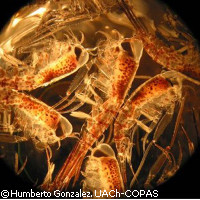German-Indian study dampens ocean fertilisation hopes
The potential of the Southern Ocean to soak up extra carbon dioxide appears to be more limited then previously thought, according to preliminary results from a German-Indian study. The aim of the LOHAFEX ('loha' is Hindi for iron, while 'FEX' stands for 'fertilisation experiment') study was to investigate the effects of iron fertilisation on the ecology of the Southern Ocean and its ability to soak up additional carbon dioxide from the atmosphere. During the LOHAFEX study, 70 scientists from 7 countries spent two and a half months on the research ship Polarstern in the notorious 'roaring forties', where strong winds and storms are common; at times, the expedition researchers braved winds in excess of 120 km/h, and the ship even had to leave the study area on two occasions to avoid powerful storms. In spite of the weather, the researchers succeeded in carrying out their experiments, which entailed fertilising a 300-square-kilometre patch of ocean with 6 tonnes of dissolved iron. The location chosen was inside the core of an eddy, a vast rotating water column with an area of around 10,000 square kilometres. For 39 days, the researchers analysed the effects of the extra iron on both the plankton living in the area and the ocean chemistry. At first, everything proceeded as expected, with the iron stimulating the growth of the phytoplankton, which doubled their numbers during the first two weeks of the study. Then the zooplankton (minute animals) intervened. 'The increasing grazing pressure of small crustacean zooplankton (copepods) prevented further growth of the phytoplankton bloom,' explained Dr Wajih Naqvi of India's National Institute of Oceanography (NIO). The grazing zooplankton effectively held the phytoplankton population in check, preventing further uptake of CO2. As a result, only a small amount of carbon sank out of the surface layers to be stored in the depths of the ocean; the rest remained in the surface layers of the seas. Previous experiments had had quite different results, with large amounts of carbon sinking down into the depths of the ocean. So what was the difference here? According to the scientists, those earlier experiments triggered blooms of diatoms, a type of algae which is protected from grazing zooplankton by a silica shell. When diatoms die, they sink to great depths. A shortage of silicic acid (which diatoms use to make their shells) at the LOHAFEX experiment site meant that the diatoms were unable to thrive. Meanwhile, the experiment continued to offer surprises. 'To our surprise, the iron-fertilised patch attracted large numbers of zooplankton predators belonging to the crustacean group known and amphipods,' said Professor Victor Smetacek of Germany's Alfred Wegener Institute for Polar and Marine Research. Amphipods are two to three centimetres long, and one of the most common species of amphipod, Themisto gaudichaudii, is in turn the main food of squid and fin whales in the south-western Atlantic. Until now, little was known about this important species, despite its importance to the south-western Atlantic's extensive squid fishery and the survival of the fin whales. Three weeks into the experiment, the scientists added more iron to the site. However, this had no effect on the phytoplankton, indicating that the area was already saturated with iron. The Polarstern is now making its way back to its home port of Bremerhaven, Germany, where it is scheduled to arrive towards the end of May. Once home, the scientists face the mammoth task of analysing the numerous frozen and preserved samples gathered during the epic voyage. Full results of the experiment are expected to be presented in journals and at workshops at the end of the year. The scientists are pleased with the outcome of the trip. 'It was a strenuous cruise, full of anxiety and hope as we chased our patch around the collapsing eddy,' commented Professor Setacek. 'Nevertheless, despite the hard work under difficult circumstances, LOHAFEX has been an exciting experience laced with the spirit of adventure and haunted by uncertainty quite unlike other scientific cruises.' 'Despite coming from seven different countries and having diverse scientific backgrounds, scientists on LOHAFEX worked for a common cause and lived like a big family,' added Dr Naqvi. 'The experiment thus provides and excellent example of international collaboration in interdisciplinary ocean sciences.' At the beginning of the year, the LOHAFEX study was the subject of a good deal of controversy, as environmental groups sought to block the experiment, saying it contravened international laws designed to protect the oceans. Following independent reviews by scientists in Germany and elsewhere, the experiment was given the green light at the end of January.
Countries
Germany, India



